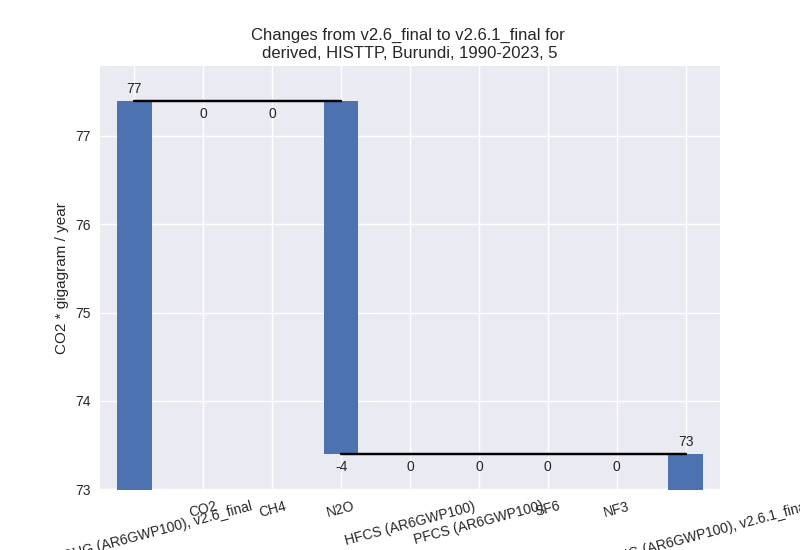Changes in PRIMAP-hist v2.6.1_final compared to v2.6_final for Burundi
2025-03-19
Johannes Gütschow
Change analysis for Burundi for PRIMAP-hist v2.6.1_final compared to v2.6_final
Overview over emissions by sector and gas
The following figures show the aggregate national total emissions excluding LULUCF AR6GWP100 for the country reported priority scenario. The dotted linesshow the v2.6_final data.
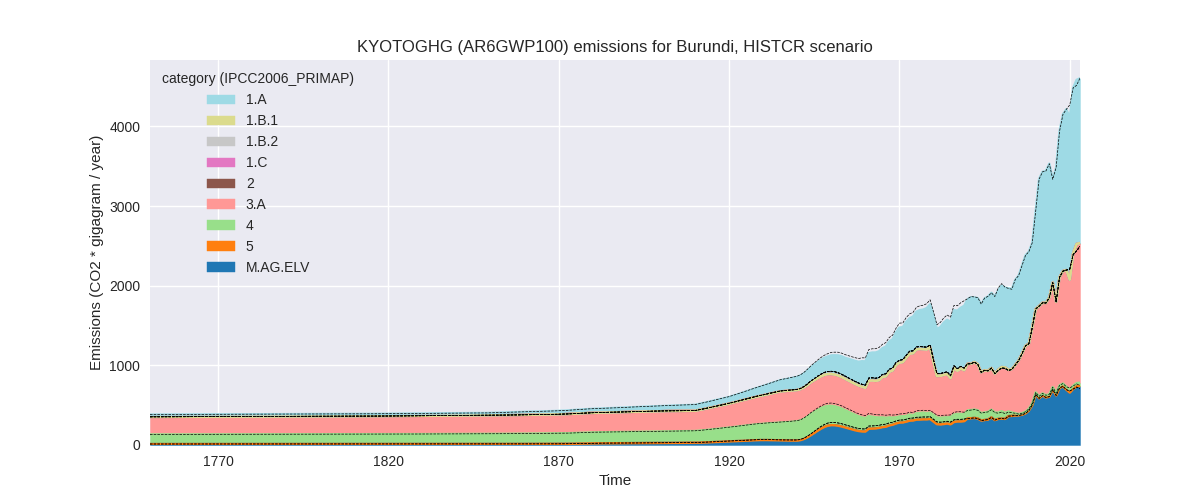
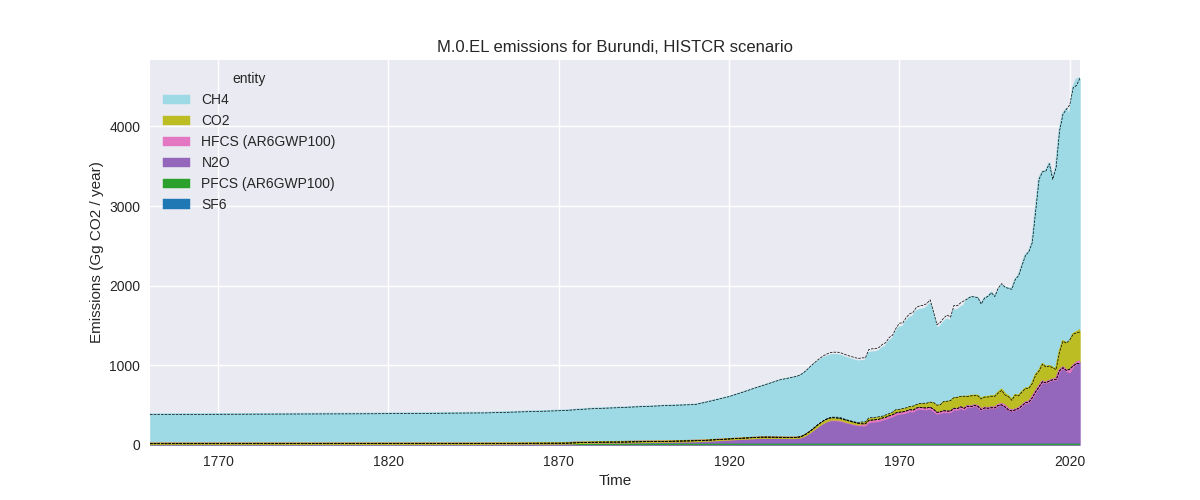
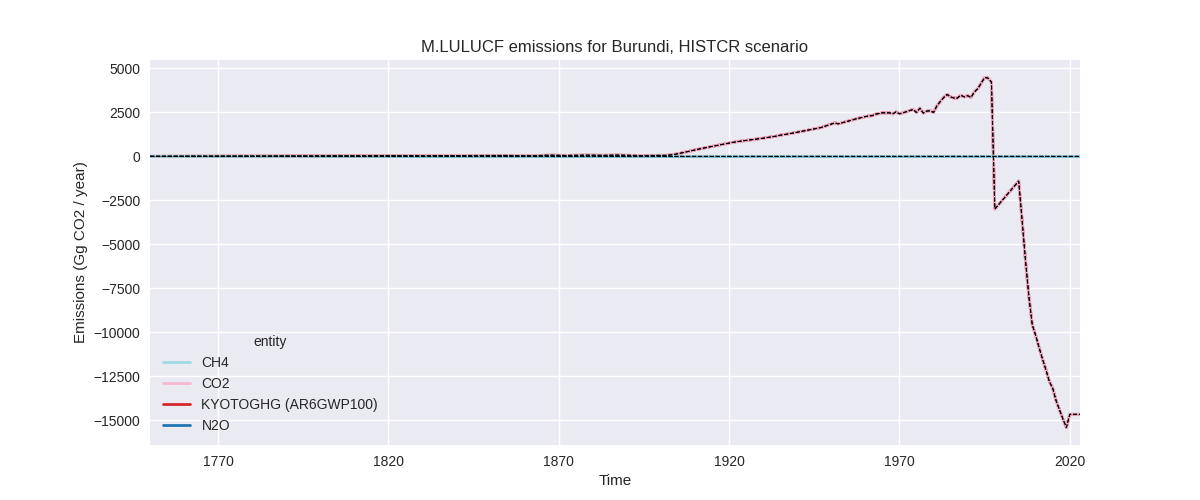
The following figures show the aggregate national total emissions excluding LULUCF AR6GWP100 for the third party priority scenario. The dotted linesshow the v2.6_final data.
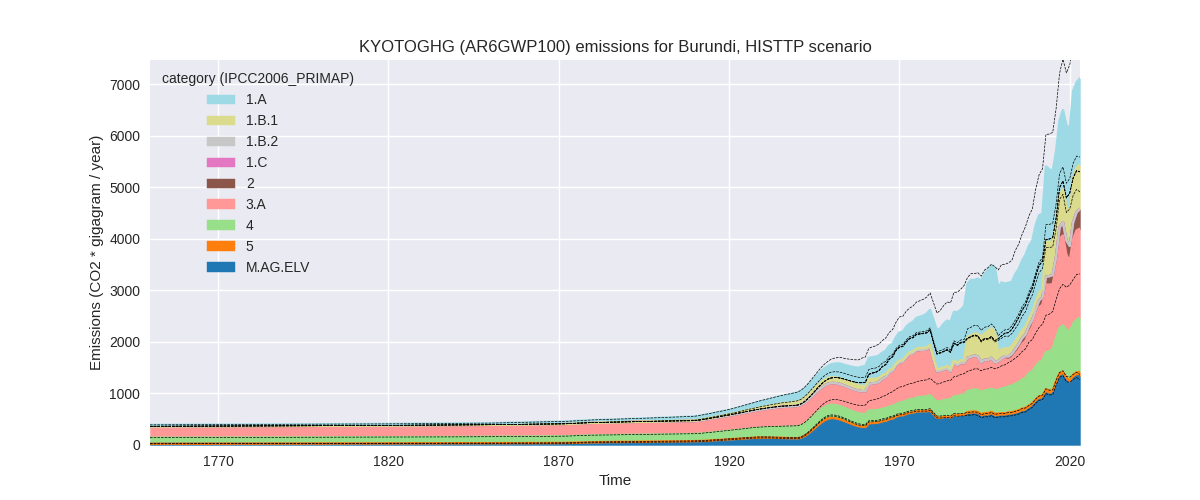
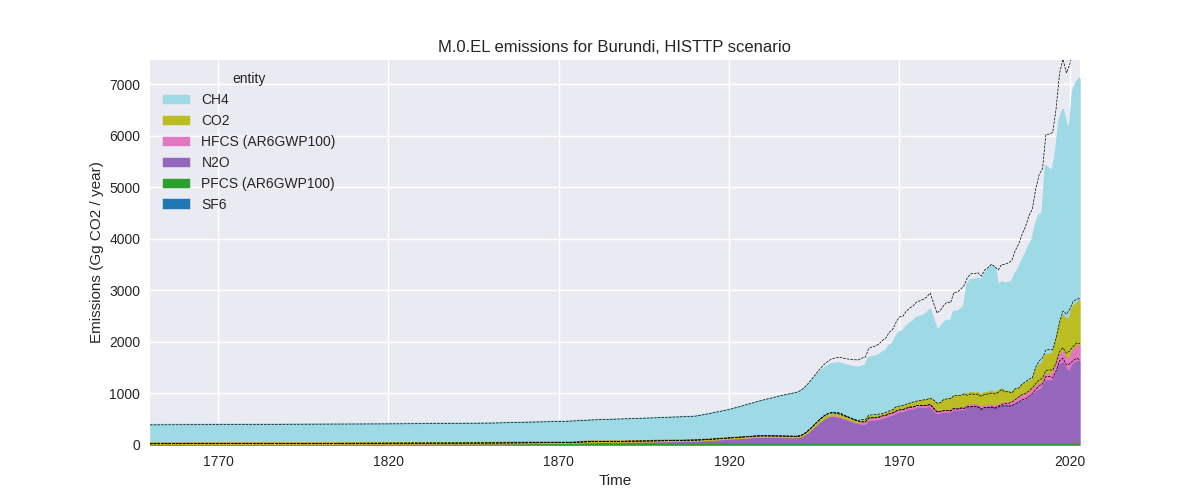
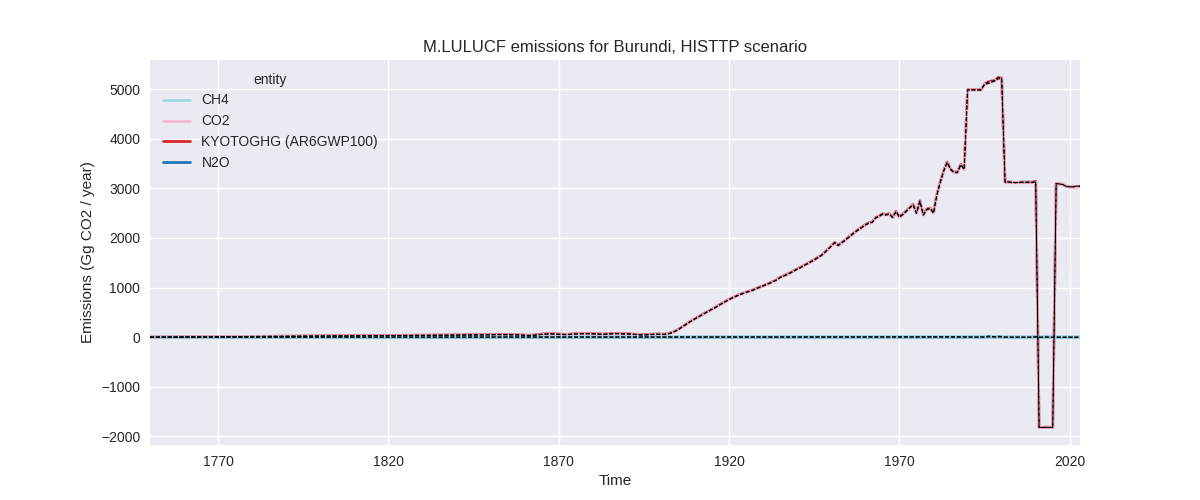
Overview over changes
In the country reported priority scenario we have the following changes for aggregate Kyoto GHG and national total emissions excluding LULUCF (M.0.EL):
- Emissions in 2023 have changed by -0.1%% (-4.28 Gg CO2 / year)
- Emissions in 1990-2023 have changed by -0.2%% (-6.45 Gg CO2 / year)
In the third party priority scenario we have the following changes for aggregate Kyoto GHG and national total emissions excluding LULUCF (M.0.EL):
- Emissions in 2023 have changed by -9.4%% (-741.01 Gg CO2 / year)
- Emissions in 1990-2023 have changed by -10.6%% (-518.64 Gg CO2 / year)
Most important changes per scenario and time frame
In the country reported priority scenario the following sector-gas combinations have the highest absolute impact on national total KyotoGHG (AR6GWP100) emissions in 2023 (top 5):
- 1: 1.A, CH4 with -38.45 Gg CO2 / year (-2.5%)
- 2: M.AG.ELV, N2O with 20.09 Gg CO2 / year (3.5%)
- 3: M.AG.ELV, CH4 with 16.31 Gg CO2 / year (13.5%)
- 4: 3.A, N2O with 7.89 Gg CO2 / year (3.5%)
- 5: 1.A, N2O with -6.09 Gg CO2 / year (-3.0%)
In the country reported priority scenario the following sector-gas combinations have the highest absolute impact on national total KyotoGHG (AR6GWP100) emissions in 1990-2023 (top 5):
- 1: 1.A, CH4 with -7.01 Gg CO2 / year (-0.7%)
- 2: 4, N2O with 1.23 Gg CO2 / year (2.9%)
- 3: M.AG.ELV, CH4 with 0.95 Gg CO2 / year (0.8%)
- 4: 1.A, N2O with -0.82 Gg CO2 / year (-0.6%)
- 5: 3.A, CH4 with -0.79 Gg CO2 / year (-0.1%)
In the third party priority scenario the following sector-gas combinations have the highest absolute impact on national total KyotoGHG (AR6GWP100) emissions in 2023 (top 5):
- 1: 4, CH4 with -875.44 Gg CO2 / year (-47.8%)
- 2: 1.B.1, CH4 with 570.56 Gg CO2 / year (202.3%)
- 3: 1.A, CH4 with -530.26 Gg CO2 / year (-40.5%)
- 4: 3.A, CH4 with 133.72 Gg CO2 / year (9.1%)
- 5: 1.A, N2O with -67.27 Gg CO2 / year (-37.9%)
In the third party priority scenario the following sector-gas combinations have the highest absolute impact on national total KyotoGHG (AR6GWP100) emissions in 1990-2023 (top 5):
- 1: 4, CH4 with -565.17 Gg CO2 / year (-49.0%)
- 2: 1.B.1, CH4 with 245.66 Gg CO2 / year (143.4%)
- 3: 1.A, CH4 with -160.13 Gg CO2 / year (-15.3%)
- 4: 4, N2O with -21.75 Gg CO2 / year (-30.8%)
- 5: 1.A, N2O with -20.14 Gg CO2 / year (-14.4%)
Notes on data changes
Here we list notes explaining important emissions changes for the country.
- Country reported data has not been updated and changes in the CR time-series are mostly in the latest years and due to changes in the third party data used for extrapolation.
- Changes in the TP scenario are higher, especially in sectors 1.A, 1.B.1, and 4 for CH4. These changes come from changed EDGAR data. Agricultural data is also subject to changes due to updated FAO data.
Changes by sector and gas
For each scenario and time frame the changes are displayed for all individual sectors and all individual gases. In the sector plot we use aggregate Kyoto GHGs in AR6GWP100. In the gas plot we usenational total emissions without LULUCF.
country reported scenario
2023
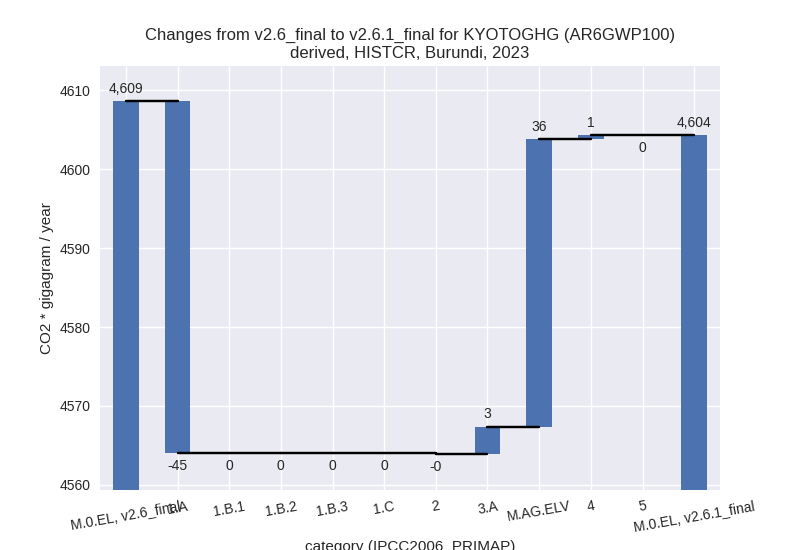
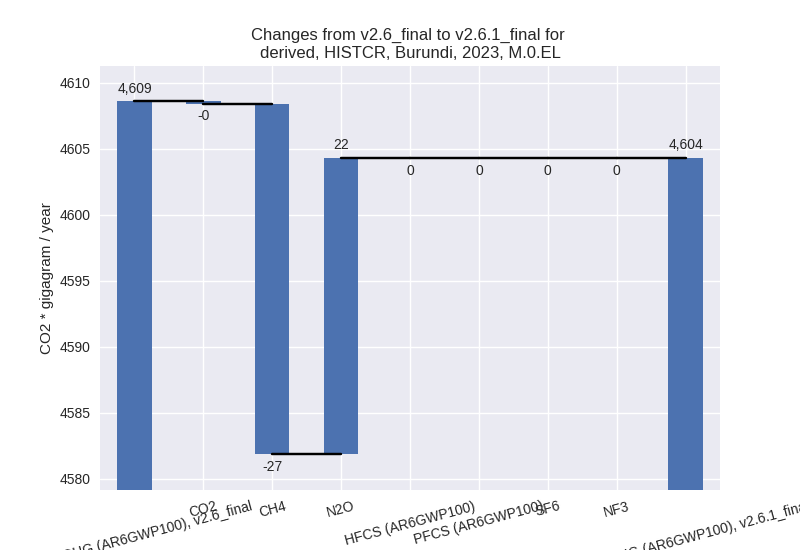
1990-2023
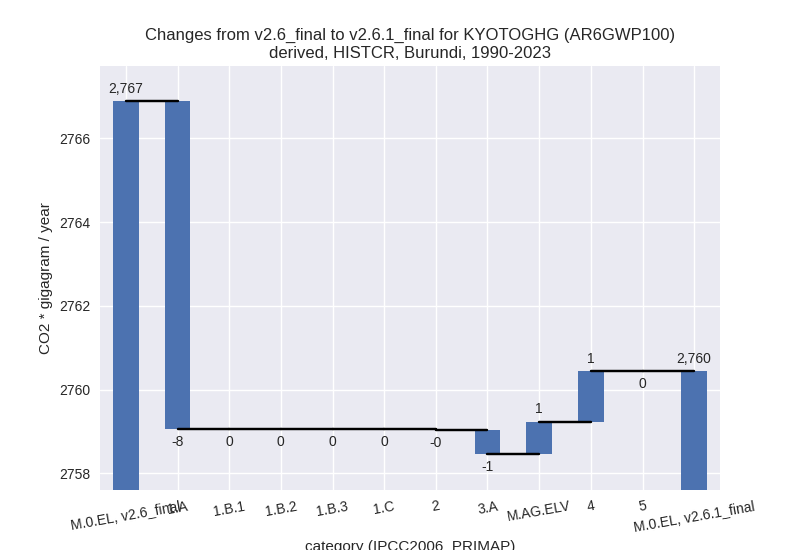
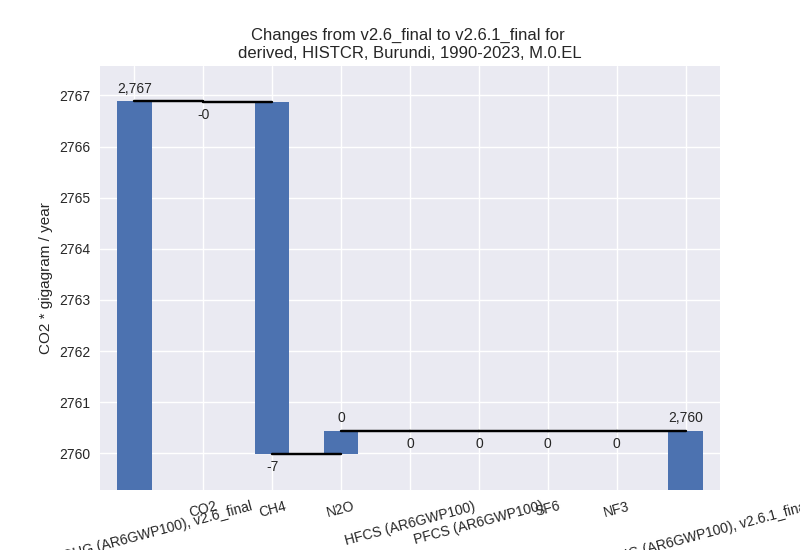
third party scenario
2023
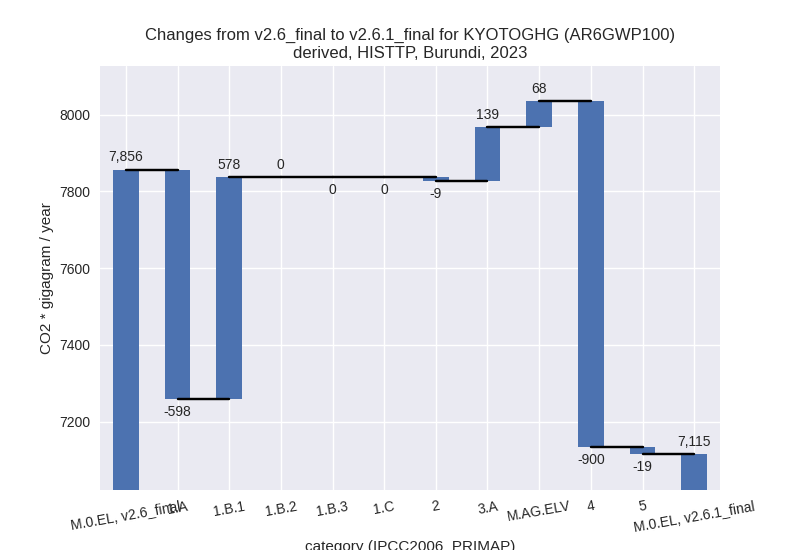
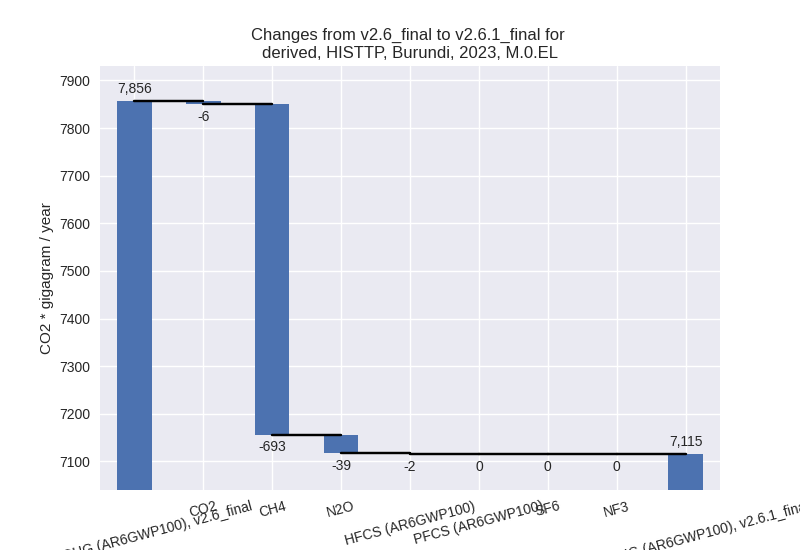
1990-2023
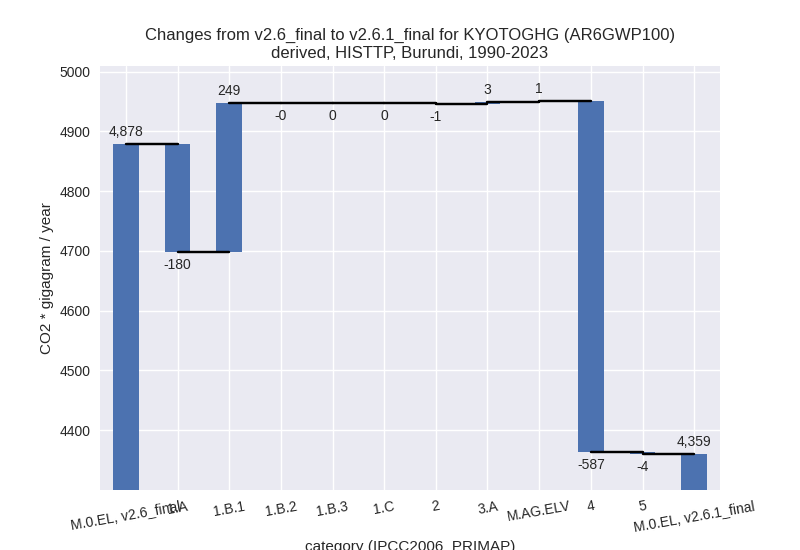
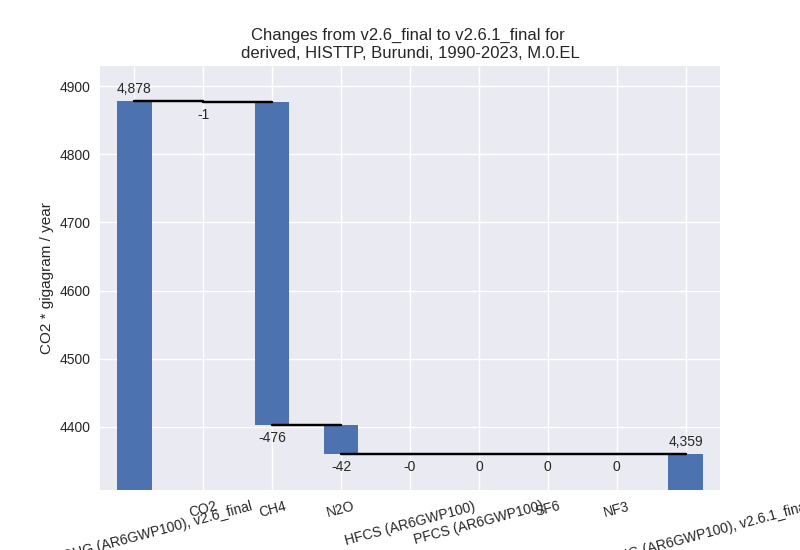
Detailed changes for the scenarios:
country reported scenario (HISTCR):
Most important changes per time frame
For 2023 the following sector-gas combinations have the highest absolute impact on national total KyotoGHG (AR6GWP100) emissions in 2023 (top 5):
- 1: 1.A, CH4 with -38.45 Gg CO2 / year (-2.5%)
- 2: M.AG.ELV, N2O with 20.09 Gg CO2 / year (3.5%)
- 3: M.AG.ELV, CH4 with 16.31 Gg CO2 / year (13.5%)
- 4: 3.A, N2O with 7.89 Gg CO2 / year (3.5%)
- 5: 1.A, N2O with -6.09 Gg CO2 / year (-3.0%)
For 1990-2023 the following sector-gas combinations have the highest absolute impact on national total KyotoGHG (AR6GWP100) emissions in 1990-2023 (top 5):
- 1: 1.A, CH4 with -7.01 Gg CO2 / year (-0.7%)
- 2: 4, N2O with 1.23 Gg CO2 / year (2.9%)
- 3: M.AG.ELV, CH4 with 0.95 Gg CO2 / year (0.8%)
- 4: 1.A, N2O with -0.82 Gg CO2 / year (-0.6%)
- 5: 3.A, CH4 with -0.79 Gg CO2 / year (-0.1%)
Changes in the main sectors for aggregate KyotoGHG (AR6GWP100) are
- 1: Total sectoral emissions in 2022 are 2060.61 Gg
CO2 / year which is 44.9% of M.0.EL emissions. 2023 Emissions have
changed by -2.1% (-44.54 Gg CO2 /
year). 1990-2023 Emissions have changed by -0.6% (-7.84 Gg CO2 / year). For 2023 the
changes per gas
are:
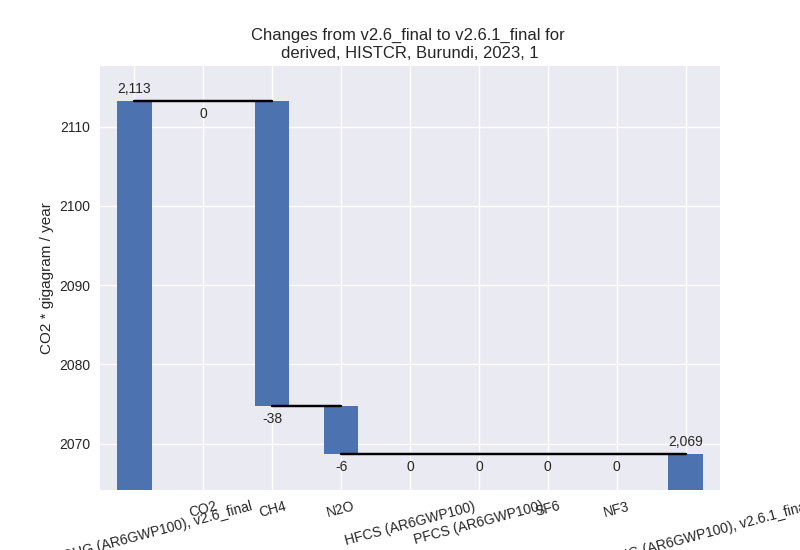
The changes come from the following subsectors:- 1.A: Total sectoral emissions in 2022 are 2060.61
Gg CO2 / year which is 100.0% of category 1 emissions. 2023 Emissions
have changed by -2.1% (-44.54 Gg CO2
/ year). 1990-2023 Emissions have changed by -0.6% (-7.84 Gg CO2 / year). For 2023 the
changes per gas
are:
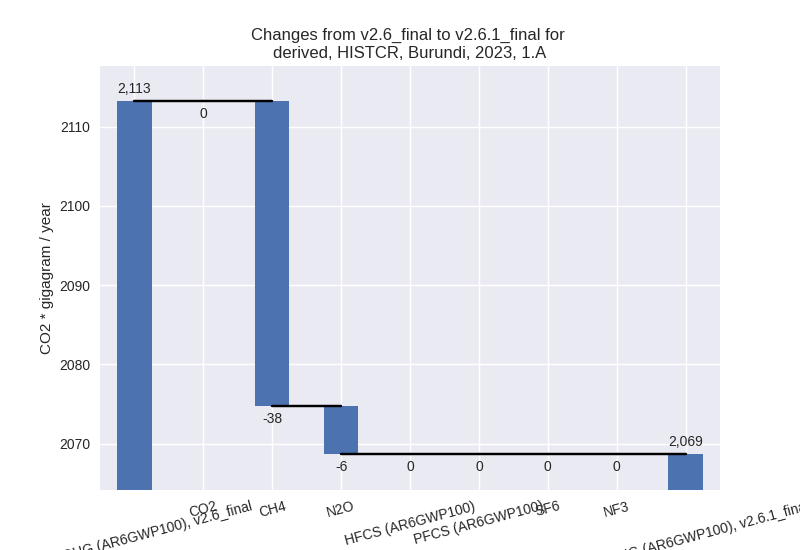
There is no subsector information available in PRIMAP-hist.
- 1.A: Total sectoral emissions in 2022 are 2060.61
Gg CO2 / year which is 100.0% of category 1 emissions. 2023 Emissions
have changed by -2.1% (-44.54 Gg CO2
/ year). 1990-2023 Emissions have changed by -0.6% (-7.84 Gg CO2 / year). For 2023 the
changes per gas
are:
- 2: Total sectoral emissions in 2022 are 4.30 Gg CO2
/ year which is 0.1% of M.0.EL emissions. 2023 Emissions have changed by
-3.7% (-0.17 Gg CO2 / year).
1990-2023 Emissions have changed by -1.1% (-0.02 Gg CO2 / year). For 2023 the
changes per gas
are:
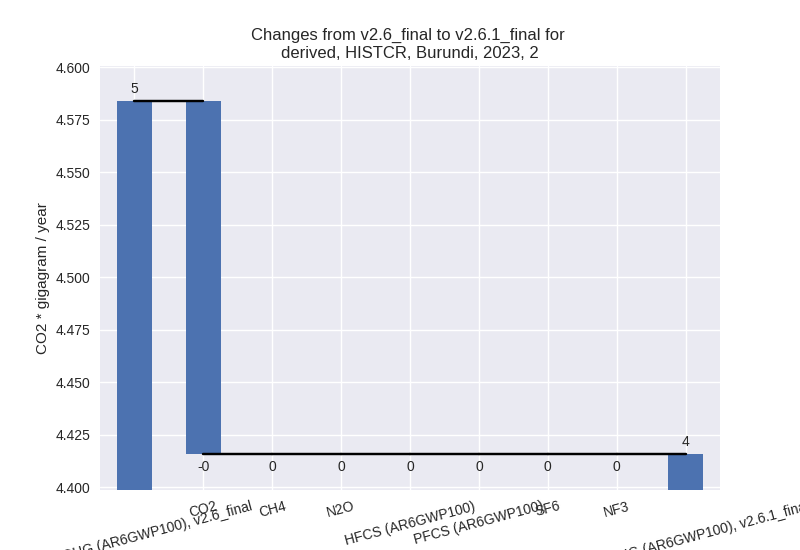
- M.AG: Total sectoral emissions in 2022 are 2479.75 Gg CO2 / year which is 54.1% of M.0.EL emissions. 2023 Emissions have changed by 1.6% (39.89 Gg CO2 / year). 1990-2023 Emissions have changed by 0.0% (0.21 Gg CO2 / year).
- 4: Total sectoral emissions in 2022 are 40.04 Gg
CO2 / year which is 0.9% of M.0.EL emissions. 2023 Emissions have
changed by 1.3% (0.54 Gg CO2 /
year). 1990-2023 Emissions have changed by 2.3% (1.21 Gg CO2 / year). For 1990-2023
the changes per gas
are:
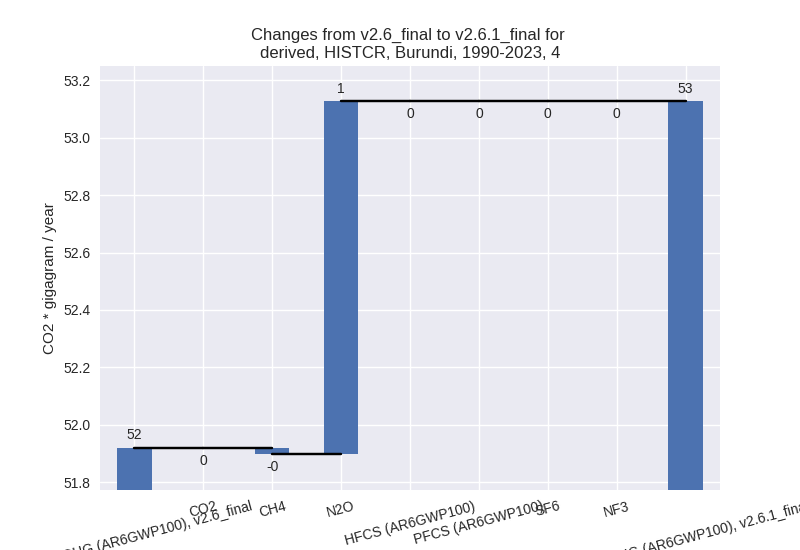
- 5: No data
third party scenario (HISTTP):
Most important changes per time frame
For 2023 the following sector-gas combinations have the highest absolute impact on national total KyotoGHG (AR6GWP100) emissions in 2023 (top 5):
- 1: 4, CH4 with -875.44 Gg CO2 / year (-47.8%)
- 2: 1.B.1, CH4 with 570.56 Gg CO2 / year (202.3%)
- 3: 1.A, CH4 with -530.26 Gg CO2 / year (-40.5%)
- 4: 3.A, CH4 with 133.72 Gg CO2 / year (9.1%)
- 5: 1.A, N2O with -67.27 Gg CO2 / year (-37.9%)
For 1990-2023 the following sector-gas combinations have the highest absolute impact on national total KyotoGHG (AR6GWP100) emissions in 1990-2023 (top 5):
- 1: 4, CH4 with -565.17 Gg CO2 / year (-49.0%)
- 2: 1.B.1, CH4 with 245.66 Gg CO2 / year (143.4%)
- 3: 1.A, CH4 with -160.13 Gg CO2 / year (-15.3%)
- 4: 4, N2O with -21.75 Gg CO2 / year (-30.8%)
- 5: 1.A, N2O with -20.14 Gg CO2 / year (-14.4%)
Changes in the main sectors for aggregate KyotoGHG (AR6GWP100) are
- 1: Total sectoral emissions in 2022 are 2518.88 Gg
CO2 / year which is 35.8% of M.0.EL emissions. 2023 Emissions have
changed by -0.8% (-19.41 Gg CO2 /
year). 1990-2023 Emissions have changed by 4.0% (68.66 Gg CO2 / year). For 1990-2023
the changes per gas
are:
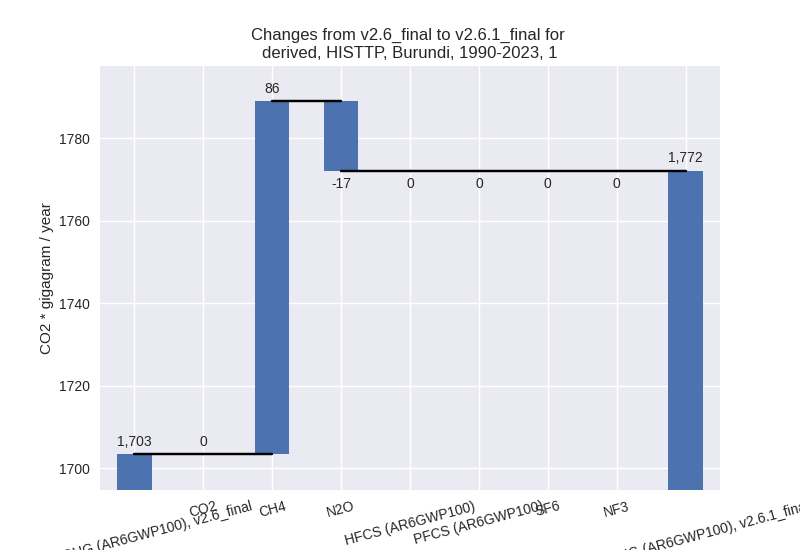
The changes come from the following subsectors:- 1.A: Total sectoral emissions in 2022 are 1654.94
Gg CO2 / year which is 65.7% of category 1 emissions. 2023 Emissions
have changed by -26.3% (-597.54 Gg
CO2 / year). 1990-2023 Emissions have changed by -11.8% (-180.26 Gg CO2 / year). For 2023
the changes per gas
are:
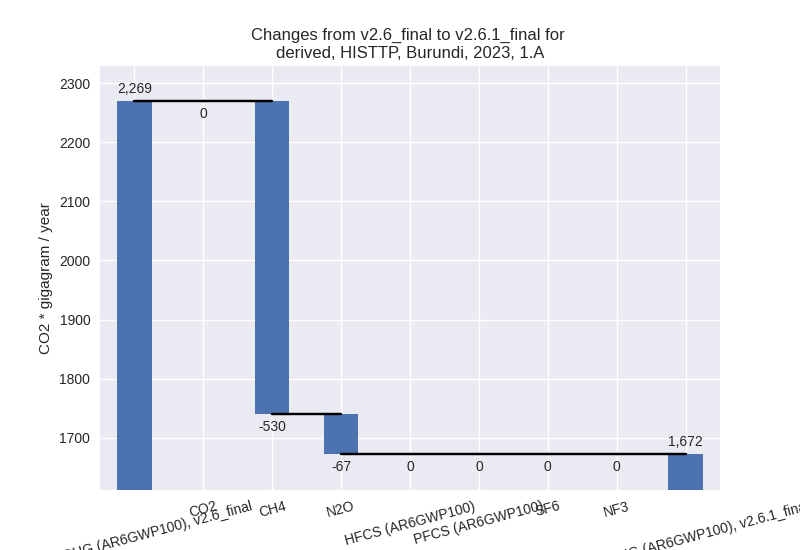
For 1990-2023 the changes per gas are: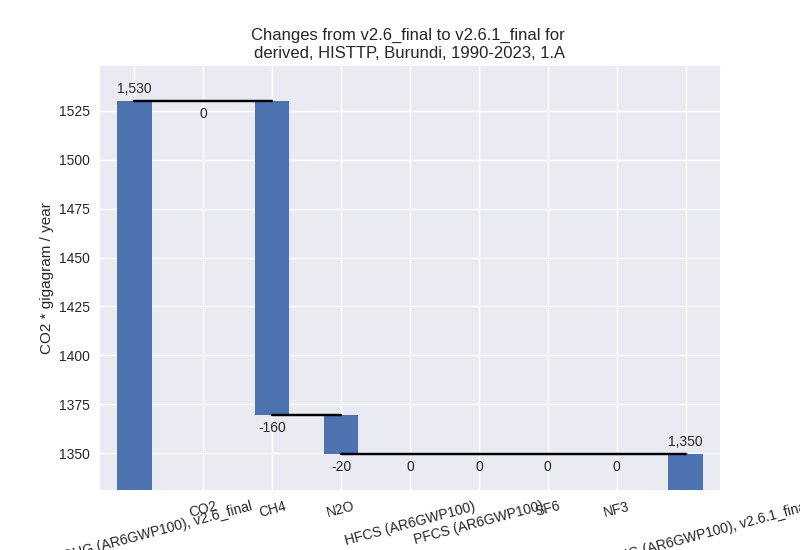
There is no subsector information available in PRIMAP-hist. - 1.B.1: Total sectoral emissions in 2022 are 863.94
Gg CO2 / year which is 34.3% of category 1 emissions. 2023 Emissions
have changed by 202.3% (578.13 Gg
CO2 / year). 1990-2023 Emissions have changed by 143.4% (248.92 Gg CO2 / year). For 2023
the changes per gas
are:
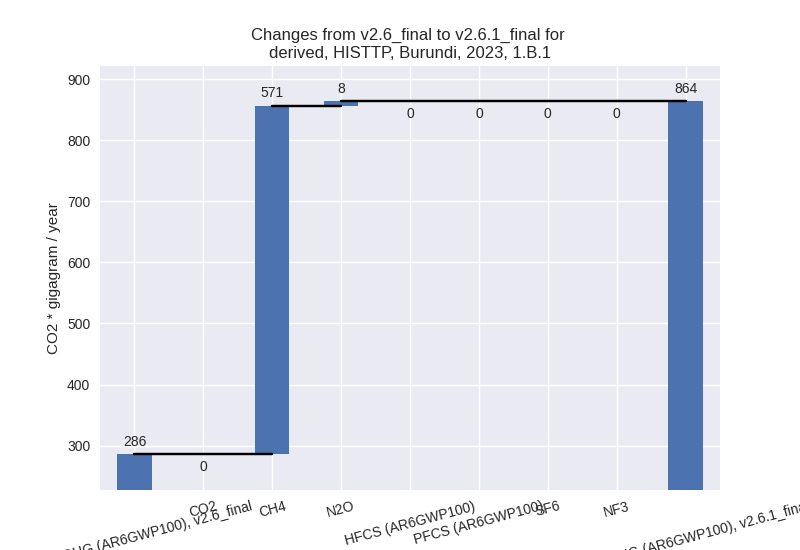
For 1990-2023 the changes per gas are: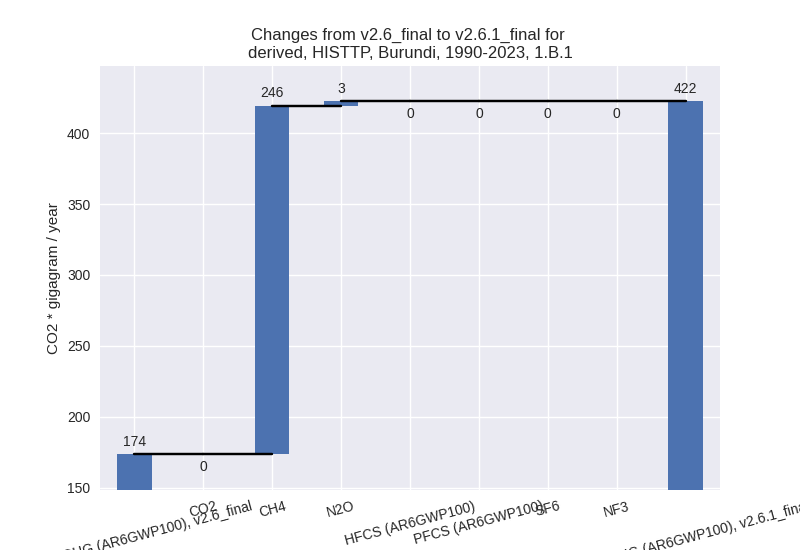
There is no subsector information available in PRIMAP-hist. - 1.B.2: Total sectoral emissions in 2022 are 0.00 Gg
CO2 / year which is 0.0% of category 1 emissions. 2023 Emissions have
changed by 20.6% (0.00 Gg CO2 /
year). 1990-2023 Emissions have changed by -0.4% (-0.00 Gg CO2 / year). For 2023 the
changes per gas
are:
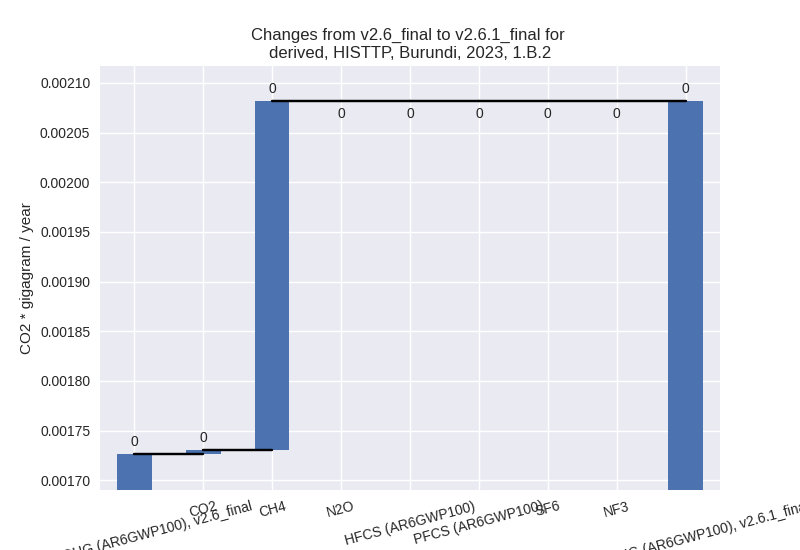
There is no subsector information available in PRIMAP-hist.
- 1.A: Total sectoral emissions in 2022 are 1654.94
Gg CO2 / year which is 65.7% of category 1 emissions. 2023 Emissions
have changed by -26.3% (-597.54 Gg
CO2 / year). 1990-2023 Emissions have changed by -11.8% (-180.26 Gg CO2 / year). For 2023
the changes per gas
are:
- 2: Total sectoral emissions in 2022 are 355.61 Gg
CO2 / year which is 5.1% of M.0.EL emissions. 2023 Emissions have
changed by -2.2% (-8.65 Gg CO2 /
year). 1990-2023 Emissions have changed by -0.7% (-0.95 Gg CO2 / year). For 2023 the
changes per gas
are:
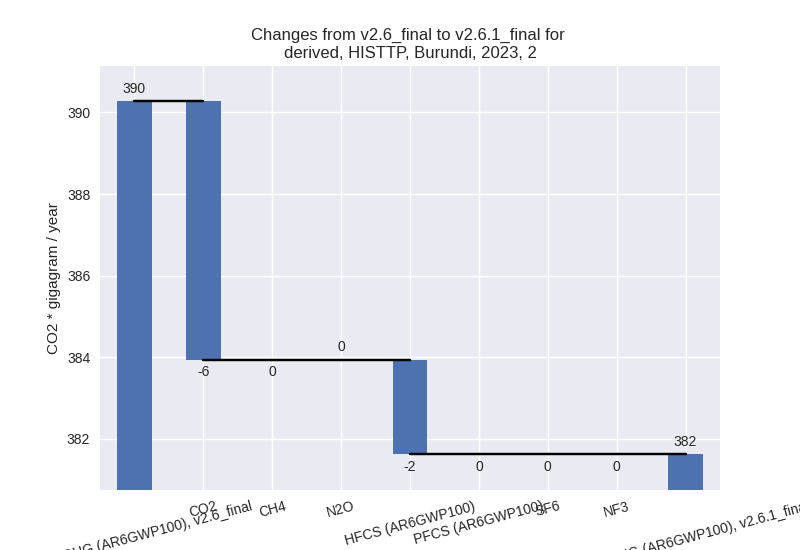
- M.AG: Total sectoral emissions in 2022 are 3058.10
Gg CO2 / year which is 43.5% of M.0.EL emissions. 2023 Emissions have
changed by 7.2% (206.65 Gg CO2 /
year). 1990-2023 Emissions have changed by 0.3% (4.57 Gg CO2 / year). For 2023 the
changes per gas
are:
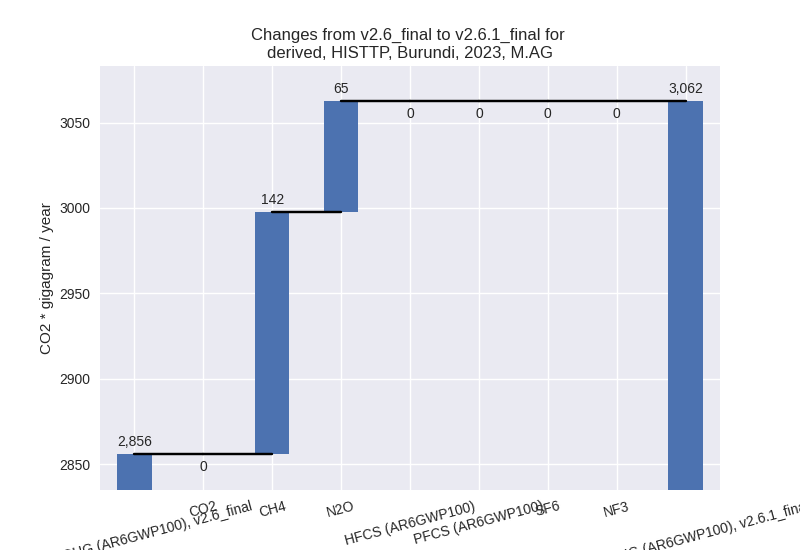
The changes come from the following subsectors:- 3.A: Total sectoral emissions in 2022 are 1730.83
Gg CO2 / year which is 56.6% of category M.AG emissions. 2023 Emissions
have changed by 8.7% (138.77 Gg CO2
/ year). 1990-2023 Emissions have changed by 0.4% (3.42 Gg CO2 / year). For 2023 the
changes per gas
are:
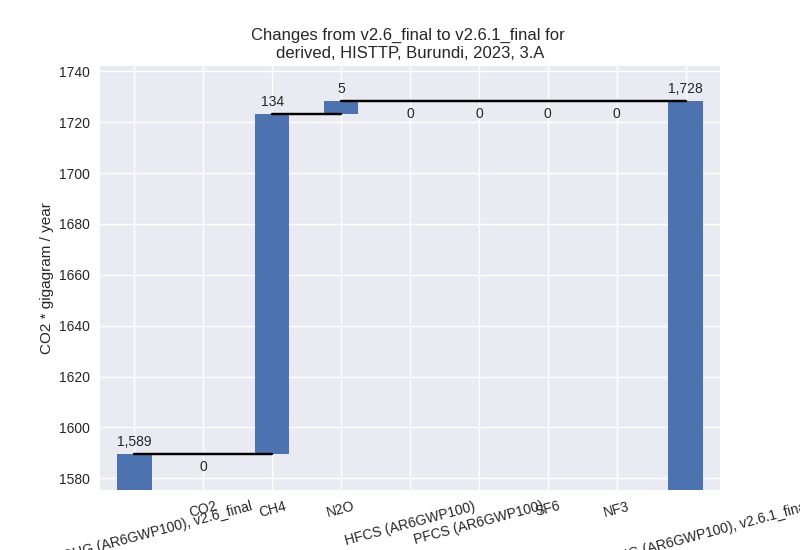
There is no subsector information available in PRIMAP-hist. - M.AG.ELV: Total sectoral emissions in 2022 are
1327.27 Gg CO2 / year which is 43.4% of category M.AG emissions. 2023
Emissions have changed by 5.4%
(67.88 Gg CO2 / year). 1990-2023 Emissions have changed by 0.1% (1.15 Gg CO2 / year). For 2023 the
changes per gas
are:
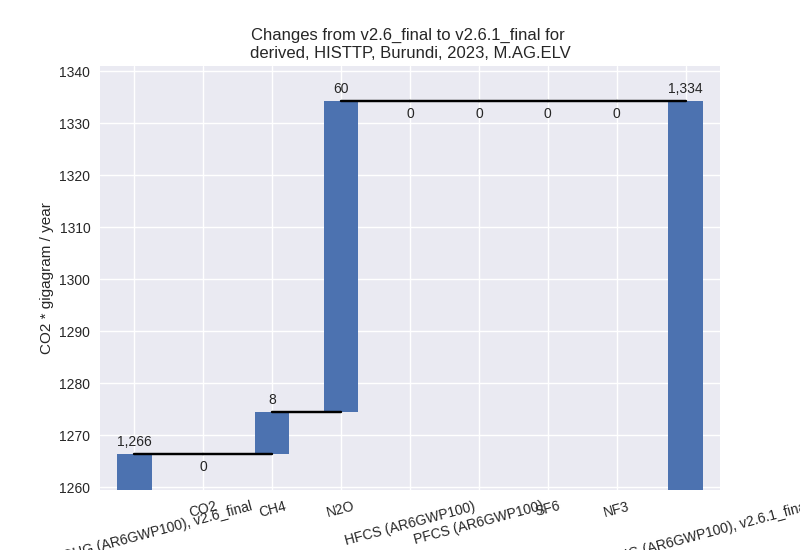
There is no subsector information available in PRIMAP-hist.
- 3.A: Total sectoral emissions in 2022 are 1730.83
Gg CO2 / year which is 56.6% of category M.AG emissions. 2023 Emissions
have changed by 8.7% (138.77 Gg CO2
/ year). 1990-2023 Emissions have changed by 0.4% (3.42 Gg CO2 / year). For 2023 the
changes per gas
are:
- 4: Total sectoral emissions in 2022 are 1021.77 Gg
CO2 / year which is 14.5% of M.0.EL emissions. 2023 Emissions have
changed by -46.1% (-900.12 Gg CO2 /
year). 1990-2023 Emissions have changed by -47.9% (-586.92 Gg CO2 / year). For 2023
the changes per gas
are:
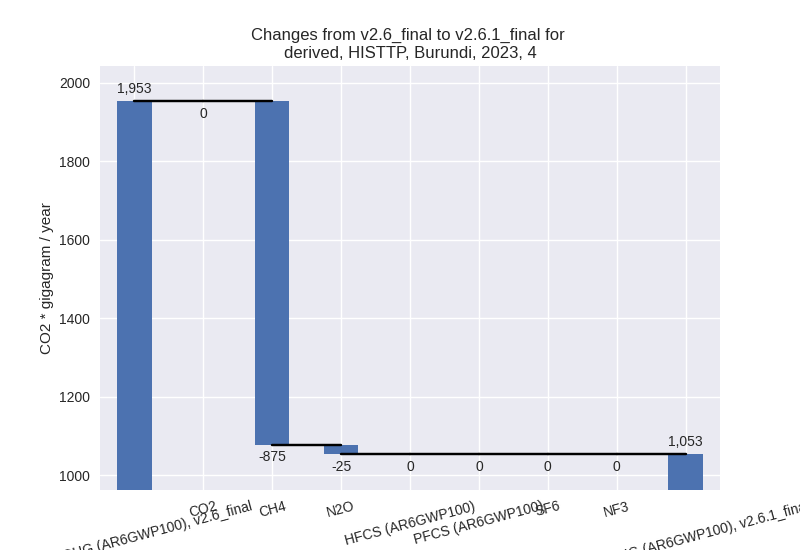
For 1990-2023 the changes per gas are: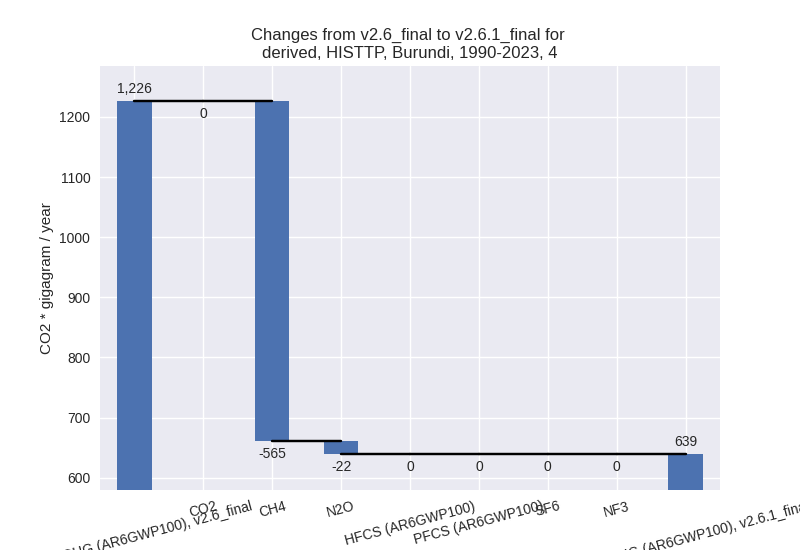
- 5: Total sectoral emissions in 2022 are 82.19 Gg
CO2 / year which is 1.2% of M.0.EL emissions. 2023 Emissions have
changed by -19.2% (-19.48 Gg CO2 /
year). 1990-2023 Emissions have changed by -5.2% (-4.00 Gg CO2 / year). For 2023 the
changes per gas
are:
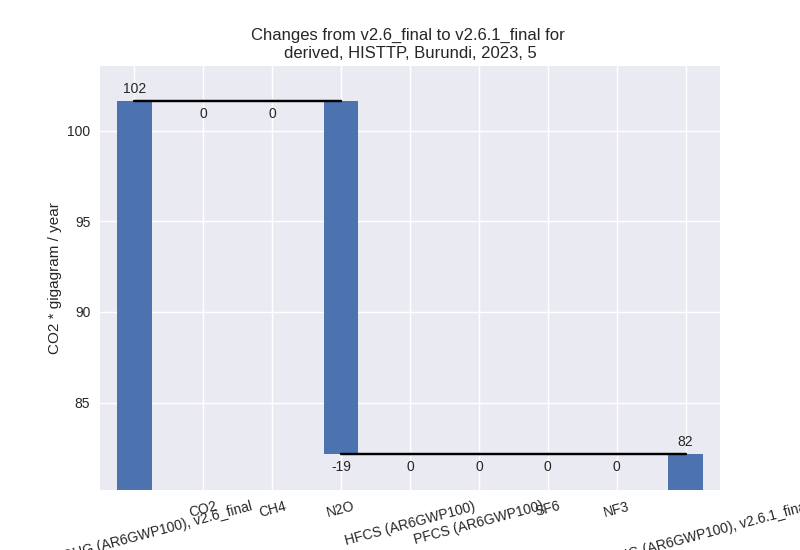
For 1990-2023 the changes per gas are: